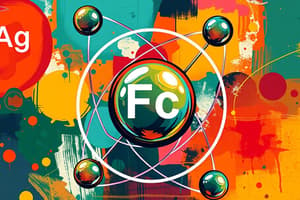Podcast
Questions and Answers
What defines the atomic number of an element?
What defines the atomic number of an element?
- The number of neutrons in the nucleus
- The number of protons in the nucleus (correct)
- The number of electrons in the outer shell
- The total number of protons and neutrons
What is the primary difference between cations and anions?
What is the primary difference between cations and anions?
- Cations are formed by losing neutrons, while anions are formed by gaining protons.
- Cations lose electrons, resulting in a positive charge, while anions gain electrons, resulting in a negative charge. (correct)
- Cations are formed from different types of molecules, while anions are not.
- Cations are always larger than anions.
What role do valence electrons play in atomic stability?
What role do valence electrons play in atomic stability?
- They are always present in the nucleus of an atom.
- They are crucial for forming ionic bonds only.
- They do not affect the properties of molecules.
- They determine the reactivity of an atom by striving for a stable electron configuration. (correct)
Which of the following statements about isotopes is true?
Which of the following statements about isotopes is true?
What type of bond involves the sharing of electrons between atoms?
What type of bond involves the sharing of electrons between atoms?
What happens to the properties of molecules as they increase in size?
What happens to the properties of molecules as they increase in size?
How do intermolecular forces compare to chemical bonds?
How do intermolecular forces compare to chemical bonds?
What is the significance of a molecule's structure?
What is the significance of a molecule's structure?
Flashcards
What is an atom?
What is an atom?
The smallest unit of matter that retains the chemical properties of an element. It consists of a nucleus containing protons and neutrons, surrounded by electrons orbiting in energy levels.
What is an ion?
What is an ion?
Atoms or groups of atoms that carry a net electric charge due to losing or gaining electrons.
What is a cation?
What is a cation?
Positively charged ions formed when an atom loses electrons.
What is an anion?
What is an anion?
Signup and view all the flashcards
What is a molecule?
What is a molecule?
Signup and view all the flashcards
What is a covalent bond?
What is a covalent bond?
Signup and view all the flashcards
What is the valence shell of an atom?
What is the valence shell of an atom?
Signup and view all the flashcards
What are intermolecular forces?
What are intermolecular forces?
Signup and view all the flashcards
Study Notes
Atoms
- Atoms are the basic building blocks of matter.
- They consist of a nucleus containing protons and neutrons, surrounded by orbiting electrons.
- Protons have a positive charge, electrons have a negative charge, and neutrons have no charge.
- The number of protons in an atom's nucleus defines its atomic number and determines the element.
- Different isotopes of an element have the same number of protons but different numbers of neutrons.
- Atomic mass is approximately the sum of protons and neutrons.
- Electrons occupy energy levels (shells) around the nucleus. Electrons in higher energy levels are farther from the nucleus.
- Atoms strive for a stable electron configuration.
- The outermost electron shell is known as the valence shell. The electrons in this shell are called valence electrons.
Ions
- Ions are atoms or groups of atoms that have gained or lost electrons, resulting in a net electric charge.
- Cations are positively charged ions formed by losing electrons.
- Anions are negatively charged ions formed by gaining electrons.
- Ionic compounds are formed by the electrostatic attraction between oppositely charged ions.
- The charge of an ion is usually the difference between the number of protons and the number of electrons.
Molecules
- Molecules are groups of two or more atoms held together by chemical bonds, usually covalent bonds.
- Covalent bonds involve the sharing of electrons between atoms.
- Molecules can be composed of the same element (e.g., O2) or different elements (e.g., H2O).
- The structure of a molecule, including bond angles, is crucial to its properties.
- Some molecules have a significant dipole moment due to differences in electronegativity between atoms, leading to unequal sharing of electrons.
- Molecular compounds consist of molecules rather than ions.
- Molecular formulas represent the number and types of atoms in a molecule (e.g., H2O).
- Structural formulas depict the arrangement of atoms and their bonding within a molecule.
- The properties of molecules (e.g., melting point, boiling point, solubility) depend on the type of atoms and how they are bonded.
- Intermolecular forces are attractions between molecules. These forces are weaker than chemical bonds but can significantly affect the properties of substances.
- In general, larger molecules are usually more complex with multiple bonding possibilities.
Studying That Suits You
Use AI to generate personalized quizzes and flashcards to suit your learning preferences.




